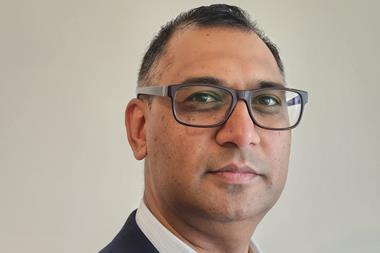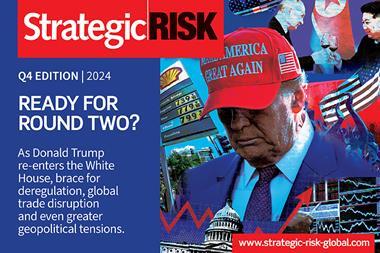Adrenaline-loving skydiver or level-headed strategic risk manager? Gentari’s Wan Norashikin Mohd Nasir shows it’s possible to be both, discussing risk personalities and the search for balance between risk and opportunity.
“I’m a natural risk taker - I love bungee jumping, I go paragliding, I have gone shark cage diving in Gaansbai, South Africa, swum with whale sharks off the coast of Western Australia” says Wan Norashikin Mohd Nasir, group risk head of clean energy company Gentari, who informally goes by Nonie.
“I may love adrenaline, but in my professional position, I’m more risk averse. There it becomes about spotting the blind spots and preparing for those difficult-to-discover risks.”

FINDING THE RISK IN RESOURCES
Nonie took on her current role with Gentari in March, bringing 20 years of risk experience to the position. “I graduated from UCL in London with a degree in chemical engineering with management principles,” she says.
“After I graduated I looked at how I could gravitate towards my strengths. I decided to go into corporate banking and worked at Citi in investment banking.
“London was a city I knew well, but my role relocated to Kuala Lumpur in Malaysia, my home country, where I was looking after business development strategies for major oil and gas portfolios.”
Nonie used this background to directly jump into the resources industry with Petronas - the largest oil and gas company in Malaysia.
“Risk needs to be about fit-for-purpose solutions rather than ticking boxes.”
“I started as a business risk analyst, then my role took me to Sudan - where I was for around six years - handling planning and operational performance and then risk management.
“They asked me to set up their risk management and business continuity management for 12 countries, including Mauritania, Turkmenistan, Sudan, Vietnam, Myanmar, Canada, Indonesia, Iraq and Mexico.”
Nonie says the broad geographical reach was matched by a diverse business portfolio that included overseeing refining and trading, lubricants, chemicals and retail.
In her final role at Petronas, she led the risk and business continuity management for a global downstream portfolio encompassing more than 90 operating companies across 30 countries.
“One of the major challenges of my career has been implementing that risk culture within a business.”
Then, after 17 years in various roles with Petronas, Nonie headed to Bangkok, where she was global vicepresident and risk and business continuity manager for Indorama Ventures. There, she restructured business continuity management for 147 plants and 19 business units, while also implementing a corporate risk strategy globally.
“Right now, I’m back where it started, in Malaysia, in a new role for me with Gentari,” she says.
Reflecting on all of her previous risk roles, Nonie says that while risk and compliance is often seen as a dry subject, or something focused on the negative, a career in risk is just about “having the right risk mindset”.
“Risk needs to be about fit-for-purpose solutions rather than ticking boxes. One of the major challenges of my career has been implementing that risk culture within a business and ensuring those principles are internalised.”
CHALLENGING LOCATIONS
Nonie’s risk oversight has included several volatile and developing nations, adding additional jeopardy to risk considerations.
“Those countries involve not just sovereign risk – there is also a large amount of security risk and financial risk… One example is Venezuela where they introduced restrictions that meant that we could not repatriate funds,” she explains.
“We also operated in countries like Canada and Australia, where you face different types of risks, such as regulatory risk.
“Then in places like Sudan there are several political risks – which was why being on the ground in Sudan was so important. I needed to speak with financiers, bankers and legal firms regularly.”
LOOKING AT THE BIG PICTURE
Nonie adds that running risk exercises before you enter a country, or make mergers and acquisitions there, is vital in ensuring you are prepared for what you will face.
“Too often, people do not consider risk in its totality. Organisations are very engrossed in the day-to-day operational risk, they forget about strategic risks and emerging risks,” Nonie says.
“Look at companies like Blockbuster Video or Nokia. Those companies faced emerging risks that they did not anticipate. They did not have a strategic plan or mitigation plans for the risks they faced.”
She has provided training to her organisations on risk in strategic planning, which features a strong focus on emerging risk.
“Organisations are very engrossed in the day-to-day operational risk, they forget about strategic risks and emerging risks”
“Risks also present opportunities. So how do we leverage these emerging risks and trends to be able to put in mitigations so that we are ahead of our competitors? It is all about having strategic initiatives for the organisation that materialise into actual investment opportunities.
“There are always two angles to risk – risk and opportunity. Too often the latter is missed.”
A vital aspect of realising that balance is risk culture, she believes. “I developed an in-house bespoke risk leadership program, which was designed for the C-suite and leadership.
“It was designed to galvanise and ignite risk consciousness, and trigger challenging thoughts among leaders that enhance the risk thinking required in this world and this time.
“We want everyone to embrace a risk mindset, embedding risk thinking in their daily activities.”
“It was there to help them to better understand what’s necessary to be effective in managing risks, better understand their people, and influence them to do the right thing, given the challenges.
She adds: “We want everyone to embrace a risk mindset, embedding risk thinking in their daily activities. To be able to be more agile and manage the risks proactively.
“A lot of the time, risk management is on paper, but you need experiential learning. The actual value is in the conversations we hold. You get to go beyond the surface and pull at the threads to reach those opportunities.”
KNOWING YOUR RISK PERSONALITY
Nonie believes that another useful tool is risk personality profiling because everyone has a different risk predisposition.
“Take me, I’m a risk manager but I’m a risk taker in my personal life,” she says.
“Sometimes you need to be a bit more risk-taking, but your predisposition might be to be risk averse. That’s why you need to be aware and conscious to overcome that imbalance.
“By being conscious of that, you are better prepared for the role you have to play. I might be a natural risk taker in life but in my role, I become the devil’s advocate. I play a balancing role, making sure we are setting standards and being consistent.”
“I work with leaders and stakeholders to make sure there is an integrated view of risk across the business”
She says that while you must take a view of risks across different businesses, entities and countries, there must be transparency within an organisation to achieve that.
“For me, it is about helping the project and management teams uncover those risks so they can be mitigated. For the decision-makers, they want to know the risk/reward trade-off. In the end, the management and board are accountable for all risk management practices across the business.
“I work with leaders and stakeholders to make sure there is an integrated view of risk across the business – to ensure that specific areas, such as project risk, financial risk or operational risk, are all being managed properly. You need a 360 view of risk and a line of sight on all of your key risks.”
FUTURE RISK CONCERNS
Looking ahead, Nonie says that a crucial area will be sustainability risk, with ESG and its impact on risk management being a huge issue in the future.
“There are also vast geopolitical risks, with aspects such as resource nationalism making the world less global. This is also impacting the supply chains that businesses rely on so much.”
She says that we are also in the social media era and that is having a vast impact on reputational risk.
“We need to be able to be risk aware, adaptable and transparent enough to assess all the incomprehensible risks”
“Today, a single incident can expand in the social media environment and lead to thousands of people seeing it in a very short period of time. This can have heavy repercussions for a business. There is also cybersecurity, which in recent years has grown more complex.
“The market is going to become more volatile in the coming years. So how do we ensure growth? We need to be able to be risk aware, adaptable and transparent enough to assess all the incomprehensible risks and take calculated actions to be able to sustain our growth.”














No comments yet